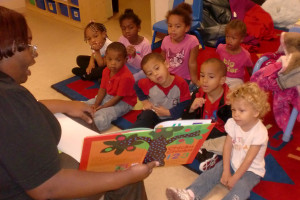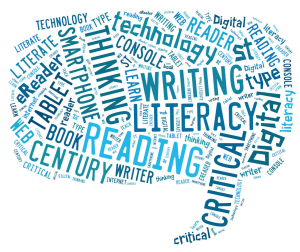It once was simple in the days before apps and the Internet. When all information came by way of books, magazines, and newspapers. Literacy was easy to define. It meant you were able to read and understand printed matter. Functional literacy was said to be the ability to read on the fourth grade level. Basic literacy as defined by the U.S. Department of Education 2003 National Assessment of Adult Literacy is using “print and written material to function in society and achieve one’s goals and to develop one’s knowledge and potential.”
However, most often today when someone refers to literacy, you need to know which type of literacy they mean. Information literacy? Digital literacy? Transliteracy? Visual Literacy? And there are more out there. The bottom line is that all these types of literacy are important, but it’s important to recognize that all these literacies –even visual literacy to some extent—rely on being able to read and comprehend text.
As school librarians we are responsible for guiding our students to develop fluency in all literacies, but we can’t forget the basics. We still must provide the print rich environment leading to a love of reading and learning. All else follows from that.
On June 13, 2013, ALA Council passed a resolution reaffirming ALA’s commitment to basic literacy, noting that the ALA Policy Manual “recognizes Literacy as a core service and responsibility of all libraries.” All types of libraries are charged with “making literacy a high priority in planning and budgeting.” In schools where administrators are pushing for book-less libraries (when they are not replacing them with computers for taking PARCC and other high stakes tests), standing up for literacy in its most basic definition is not simple.
It’s not that ALA and AASL don’t recognize we are living in a digital age. These organizations are also working at helping librarians improve their own mastery of multiple literacies to be able to share that with teachers and students. (Several years ago AASL held it biennial Fall Forum on Transliteracy.) What they realize, as noted earlier, these skills rest on basic literacy.
 How can you support basic literacy in a culture focused on technology? Do what many of the top school librarians in the country are doing. Create programs using a variety of digital resources to coincide with and connect to reading. An example of the simplest level is having students write online reviews of books. You can have a book club with another school or have pairs of students in different schools read the same book and have an online discussion which they then share with others. You don’t have to come up with these yourself. Librarians on Twitter and TL Chat on Google+ are sharing what they are doing. Respond to them with any questions. They’ll be glad to help—and get your students reading for the fun of it.
How can you support basic literacy in a culture focused on technology? Do what many of the top school librarians in the country are doing. Create programs using a variety of digital resources to coincide with and connect to reading. An example of the simplest level is having students write online reviews of books. You can have a book club with another school or have pairs of students in different schools read the same book and have an online discussion which they then share with others. You don’t have to come up with these yourself. Librarians on Twitter and TL Chat on Google+ are sharing what they are doing. Respond to them with any questions. They’ll be glad to help—and get your students reading for the fun of it.

